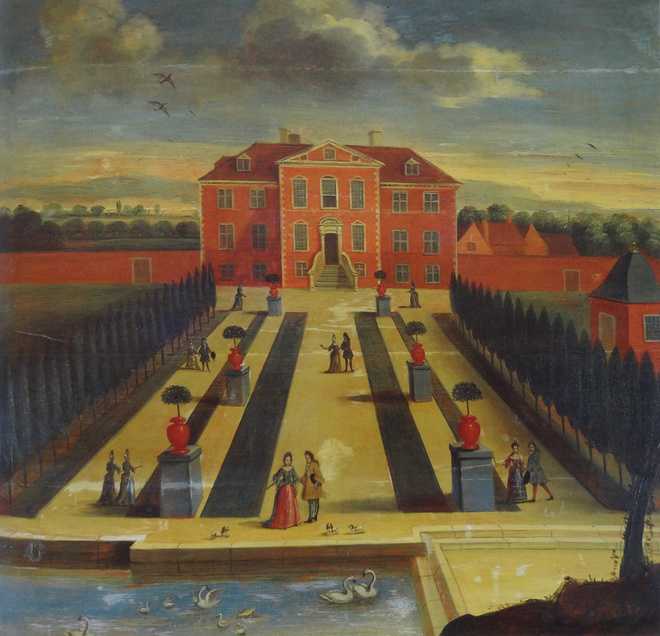
A Romantic view of a Mansion. By an unknown artist
B.N. Goswamy
The immediate delight of naïve art is its honesty, dignity, simplicity, and humour. The British naïve artist of the eighteenth and nineteenth centuries worked outside the ‘art for art’s sake’ philosophy of the (Royal) Academy. This artisan, skilled in the tools, materials and craftsmanship of his trade documented everyday subjects related to family, occupation or community. While producing an object to fulfill a social function or to meet a community need, he often created an art of unconscious sophistication that retains a timeless, universal freshness and direct appeal. — James Ayres
In the on-going but somewhat difficult distinction that we keep drawing between art and craft, I have always found the word shilpa — which goes back to very early times in our land and covers both — eminently meaningful. It is against this background that I was immediately drawn to a book, English Naïve Art, which served as a catalogue to an exhibition of the same name held in Virginia some years ago, recording the work of unknown artists of the 18th and 19th centuries. Naïve is an interesting word, to say the least: for while, in ordinary parlance, it is used to describe ‘a person or action showing a lack of experience or wisdom or judgement’, it is also used, dictionaries would tell us, as ‘denoting art produced in a style which deliberately rejects sophisticated artistic techniques and has a bold directness’.
But it is not on definitions that I write here: the art that was shown in that exhibition is what interested me a great deal. There they were in this show: the People, the Home, the Travellers, the Sports and Pastimes, each treated by different artists in their own personal styles but each possessed of great charm. The works were sometimes ascribed, or were ascribable, to individual artists (even if ‘artisan’ was the word commonly used according to the distinction formally established by the Royal Academy in 1768), but more often than not they were ‘anonymous’, so to speak. There is no record, for instance, of who painted that disarmingly engaging family ‘portrait’ of three sisters — a member of the family, some itinerant craftsman, a house-help? — but one can see that the young ladies, all ruddy cheeks, all dressed up for an occasion, all looking directly at the painter, have an indescribable innocence, that freshness which almost defines this kind of art. One is left to one’s own devices to imagine what might have been the occasion that the painting records or celebrates: a birthday perhaps? If so, was it of the youngest of the three who sits in the middle with the air of a princess all set to receive gifts: a flower, a fruit, perhaps even the affection of the family dog? One can see that the artist had limited skills for there is stiffness in the faces and stances of the girls and even a measure of artificiality in the rendering, but as a record of an occasion which could turn into a family heirloom over time, the work is seductive in its own way.
The painting of the two rams, in contrast to that of the three sisters, is much better documented. The painter’s name is known: William Henry Davis who used to sign his paintings grandiosely — whether accurate or not — as “Animal Painter to Her Majesty”; also known is the name of the owner of the two magnificent rams: Richard Lane who was one of the most famous sheep breeders of the Cotswolds. We even know the occasion for creating this pictorial record,for the animals had just won a prize; the “Second Prize Old Ram at the Royal Agricultural Show held at Exeter in July, 1850”. There is pride, therefore, in the grand appearance of the two animals: they are far from the ‘true portraits’ of animals of the kind that Mughal painters turned out sometimes — a zebra imported from Africa, for instance; a turkey-cock that Jahangir became so fascinated by — but they impress by their sheer size, and that must have been worth celebrating. Very often, pliers of different trades seem at that time to have turned their own hands at creating a cheerful record of their shops or establishments that might serve even as advertisements: an ironsmith fabricating a cockerel that was displayed as a weather-vane over his shop; a butcher fashioning a sculpture out of a block of wood that mirrors the appearance of his store. A whole range of craftsmen seem to have been at work: house painters, tradesman-carvers, builder-architects, each in his own fashion.
While seeing images that were shown in that exhibition, I was reminded of this kind of vernacular art in our own small towns and villages in the neighbourhood where large hawks or airplanes made of cement adorn roofs of families that have made their money abroad and returned home, or mason-mistris who, having finished work on a modest structure, felt the urge to paint murals on them. But does anyone create a record of them here? It would be interesting to know.



























